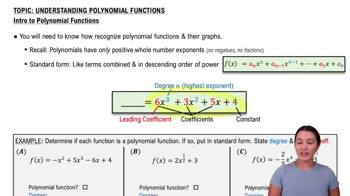Table of contents
- 0. Functions7h 52m
- Introduction to Functions16m
- Piecewise Functions10m
- Properties of Functions9m
- Common Functions1h 8m
- Transformations5m
- Combining Functions27m
- Exponent rules32m
- Exponential Functions28m
- Logarithmic Functions24m
- Properties of Logarithms34m
- Exponential & Logarithmic Equations35m
- Introduction to Trigonometric Functions38m
- Graphs of Trigonometric Functions44m
- Trigonometric Identities47m
- Inverse Trigonometric Functions48m
- 1. Limits and Continuity2h 2m
- 2. Intro to Derivatives1h 33m
- 3. Techniques of Differentiation3h 18m
- 4. Applications of Derivatives2h 38m
- 5. Graphical Applications of Derivatives6h 2m
- 6. Derivatives of Inverse, Exponential, & Logarithmic Functions2h 37m
- 7. Antiderivatives & Indefinite Integrals1h 26m
- 8. Definite Integrals4h 44m
- 9. Graphical Applications of Integrals2h 27m
- 10. Physics Applications of Integrals 2h 22m
4. Applications of Derivatives
Differentials
Problem 23b
Textbook Question
The Mean Value Theorem
a. Show that the equation 𝓍⁴ + 2𝓍² ― 2 = 0 has exactly one solution on [0,1] .
[Technology Exercises] b.Find the solution to as many decimal places as you can.
 Verified step by step guidance
Verified step by step guidance1
Step 1: Define the function f(x) = x^4 + 2x^2 - 2. We need to show that this function has exactly one solution in the interval [0,1].
Step 2: Check the endpoints of the interval. Calculate f(0) and f(1). f(0) = 0^4 + 2*0^2 - 2 = -2 and f(1) = 1^4 + 2*1^2 - 2 = 1.
Step 3: Since f(0) < 0 and f(1) > 0, by the Intermediate Value Theorem, there is at least one root in the interval (0,1).
Step 4: To show that there is exactly one solution, check the derivative f'(x) = 4x^3 + 4x. Analyze the sign of f'(x) on the interval [0,1].
Step 5: Since f'(x) = 4x(x^2 + 1) is always positive for x in [0,1], f(x) is strictly increasing on this interval. Therefore, there is exactly one root in [0,1].
 Verified video answer for a similar problem:
Verified video answer for a similar problem:This video solution was recommended by our tutors as helpful for the problem above
Video duration:
6mPlay a video:
Was this helpful?
Key Concepts
Here are the essential concepts you must grasp in order to answer the question correctly.
Mean Value Theorem
The Mean Value Theorem (MVT) states that if a function is continuous on a closed interval [a, b] and differentiable on the open interval (a, b), then there exists at least one point c in (a, b) such that the derivative at that point equals the average rate of change of the function over [a, b]. This theorem is fundamental in understanding the behavior of functions and can be used to prove the existence of solutions to equations.
Recommended video:

Fundamental Theorem of Calculus Part 1
Intermediate Value Theorem
The Intermediate Value Theorem (IVT) asserts that for any continuous function on a closed interval [a, b], if the function takes on two values f(a) and f(b), then it must also take on every value between f(a) and f(b) at least once. This theorem is crucial for establishing the existence of roots within an interval, which is essential for showing that the equation x⁴ + 2x² - 2 = 0 has a solution in [0, 1].
Recommended video:

Fundamental Theorem of Calculus Part 1
Finding Roots of Polynomials
Finding roots of polynomials involves determining the values of x for which the polynomial equals zero. Techniques such as factoring, synthetic division, and numerical methods (like the Newton-Raphson method) can be employed. In the context of the given equation, analyzing the polynomial's behavior on the interval [0, 1] can help confirm the existence and uniqueness of a root, as well as facilitate the approximation of its value.
Recommended video:

Introduction to Polynomial Functions







